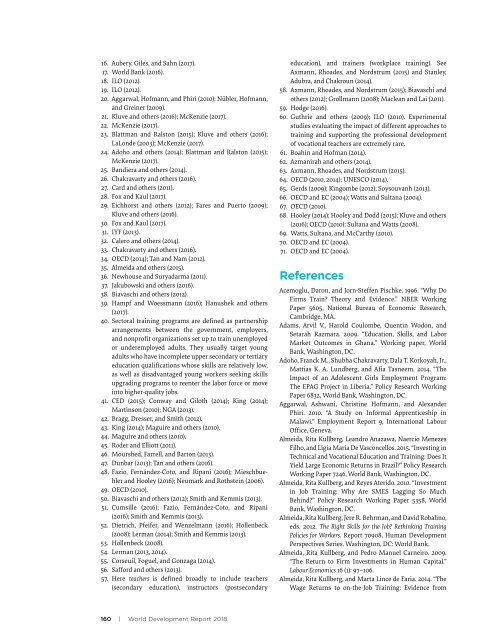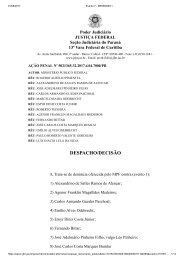Brasil só deve dominar Leitura em 260 anos, aponta estudo do Banco Mundial Relatorio Banco Mundial _Learning
You also want an ePaper? Increase the reach of your titles
YUMPU automatically turns print PDFs into web optimized ePapers that Google loves.
16. Aubery, Giles, and Sahn (2017).<br />
17. World Bank (2016).<br />
18. ILO (2012).<br />
19. ILO (2012).<br />
20. Aggarwal, Hofmann, and Phiri (2010); Nübler, Hofmann,<br />
and Greiner (2009).<br />
21. Kluve and others (2016); McKenzie (2017).<br />
22. McKenzie (2017).<br />
23. Blattman and Ralston (2015); Kluve and others (2016);<br />
LaLonde (2003); McKenzie (2017).<br />
24. A<strong>do</strong>ho and others (2014); Blattman and Ralston (2015);<br />
McKenzie (2017).<br />
25. Bandiera and others (2014).<br />
26. Chakravarty and others (2016).<br />
27. Card and others (2011).<br />
28. Fox and Kaul (2017).<br />
29. Eichhorst and others (2012); Fares and Puerto (2009);<br />
Kluve and others (2016).<br />
30. Fox and Kaul (2017).<br />
31. IYF (2013).<br />
32. Calero and others (2014).<br />
33. Chakravarty and others (2016).<br />
34. OECD (2014); Tan and Nam (2012).<br />
35. Almeida and others (2015).<br />
36. Newhouse and Suryadarma (2011).<br />
37. Jakubowski and others (2016).<br />
38. Biavaschi and others (2012).<br />
39. Hampf and Woessmann (2016); Hanushek and others<br />
(2017).<br />
40. Sectoral training programs are defined as partnership<br />
arrang<strong>em</strong>ents between the government, <strong>em</strong>ployers,<br />
and nonprofit organizations set up to train un<strong>em</strong>ployed<br />
or under<strong>em</strong>ployed adults. They usually target young<br />
adults who have incomplete upper secondary or tertiary<br />
education qualifications whose skills are relatively low,<br />
as well as disadvantaged young workers seeking skills<br />
upgrading programs to reenter the labor force or move<br />
into higher-quality jobs.<br />
41. CED (2015); Conway and Giloth (2014); King (2014);<br />
Martinson (2010); NGA (2013).<br />
42. Bragg, Dresser, and Smith (2012).<br />
43. King (2014); Maguire and others (2010).<br />
44. Maguire and others (2010).<br />
45. Roder and Elliott (2011).<br />
46. Mourshed, Farrell, and Barton (2013).<br />
47. Dunbar (2013); Tan and others (2016).<br />
48. Fazio, Fernández-Coto, and Ripani (2016); Mieschbuehler<br />
and Hooley (2016); Neumark and Rothstein (2006).<br />
49. OECD (2010).<br />
50. Biavaschi and others (2012); Smith and K<strong>em</strong>mis (2013).<br />
51. Cumsille (2016); Fazio, Fernández-Coto, and Ripani<br />
(2016); Smith and K<strong>em</strong>mis (2013).<br />
52. Dietrich, Pfeifer, and Wenzelmann (2016); Hollenbeck<br />
(2008); Lerman (2014); Smith and K<strong>em</strong>mis (2013).<br />
53. Hollenbeck (2008).<br />
54. Lerman (2013, 2014).<br />
55. Corseuil, Foguel, and Gonzaga (2014).<br />
56. Safford and others (2013).<br />
57. Here teachers is defined broadly to include teachers<br />
(secondary education), instructors (postsecondary<br />
education), and trainers (workplace training). See<br />
Axmann, Rhoades, and Nordstrum (2015) and Stanley,<br />
Adubra, and Chakroun (2014).<br />
58. Axmann, Rhoades, and Nordstrum (2015); Biavaschi and<br />
others (2012); Grollmann (2008); Maclean and Lai (2011).<br />
59. Hodge (2016).<br />
60. Guthrie and others (2009); ILO (2010). Experimental<br />
studies evaluating the impact of different approaches to<br />
training and supporting the professional <strong>deve</strong>lopment<br />
of vocational teachers are extr<strong>em</strong>ely rare.<br />
61. Boahin and Hofman (2014).<br />
62. Azmanirah and others (2014).<br />
63. Axmann, Rhoades, and Nordstrum (2015).<br />
64. OECD (2010, 2014); UNESCO (2014).<br />
65. Gerds (2009); Kingombe (2012); Soysouvanh (2013).<br />
66. OECD and EC (2004); Watts and Sultana (2004).<br />
67. OECD (2010).<br />
68. Hooley (2014); Hooley and Dodd (2015); Kluve and others<br />
(2016); OECD (2010); Sultana and Watts (2008).<br />
69. Watts, Sultana, and McCarthy (2010).<br />
70. OECD and EC (2004).<br />
71. OECD and EC (2004).<br />
References<br />
Ac<strong>em</strong>oglu, Daron, and Jorn-Steffen Pischke. 1996. “Why Do<br />
Firms Train? Theory and Evidence.” NBER Working<br />
Paper 5605, National Bureau of Economic Research,<br />
Cambridge, MA.<br />
Adams, Arvil V., Harold Coulombe, Quentin Wo<strong>do</strong>n, and<br />
Setarah Razmara. 2009. “Education, Skills, and Labor<br />
Market Outcomes in Ghana.” Working paper, World<br />
Bank, Washington, DC.<br />
A<strong>do</strong>ho, Franck M., Shubha Chakravarty, Dala T. Korkoyah, Jr.,<br />
Mattias K. A. Lundberg, and Afia Tasne<strong>em</strong>. 2014. “The<br />
Impact of an A<strong>do</strong>lescent Girls Employment Program:<br />
The EPAG Project in Liberia.” Policy Research Working<br />
Paper 6832, World Bank, Washington, DC.<br />
Aggarwal, Ashwani, Christine Hofmann, and Alexander<br />
Phiri. 2010. “A Study on Informal Apprenticeship in<br />
Malawi.” Employment Report 9, International Labour<br />
Office, Geneva.<br />
Almeida, Rita Kullberg, Leandro Anazawa, Naercio Menezes<br />
Filho, and Lígia Maria De Vasconcellos. 2015. “Investing in<br />
Technical and Vocational Education and Training: Does It<br />
Yield Large Economic Returns in Brazil?” Policy Research<br />
Working Paper 7246, World Bank, Washington, DC.<br />
Almeida, Rita Kullberg, and Reyes Ateri<strong>do</strong>. 2010. “Investment<br />
in Job Training: Why Are SMES Lagging So Much<br />
Behind?” Policy Research Working Paper 5358, World<br />
Bank, Washington, DC.<br />
Almeida, Rita Kullberg, Jere R. Behrman, and David Robalino,<br />
eds. 2012. The Right Skills for the Job? Rethinking Training<br />
Policies for Workers. Report 70908, Human Development<br />
Perspectives Series. Washington, DC: World Bank.<br />
Almeida, Rita Kullberg, and Pedro Manuel Carneiro. 2009.<br />
“The Return to Firm Investments in Human Capital.”<br />
Labour Economics 16 (1): 97–106.<br />
Almeida, Rita Kullberg, and Marta Lince de Faria. 2014. “The<br />
Wage Returns to on-the-Job Training: Evidence from<br />
160 | World Development Report 2018








